 |
PO
Box 9021, Wilmington, DE 19809, USA
E-mail: font@focusonnature.com
Phone: Toll-free in USA 1-888-721-3555
or 302/529-1876 |
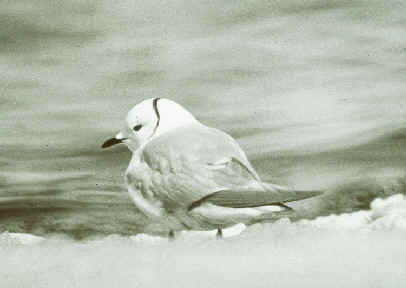 The
Birds
of
The
Birds
of
North America
Jaegers to Cuckoos
Part 3 of a List
and Photo Gallery
of
North American Birds
compiled by Armas Hill
Noting those found during Focus On Nature Tours in Alaska, Arizona,
British Columbia, California, Colorado, Delaware, Florida, Iowa, Kansas, North
Carolina, Nebraska, Newfoundland, New Jersey, New Mexico, Oklahoma, Texas,
Virginia, Washington State, & Wyoming, including offshore pelagic trips
Birds found during FONT tours & pelagic trips have an (*).
PHOTO AT UPPER RIGHT: ROSS'S GULL
(photo by Alan Brady)
CODES:
In the list that follows, birds found during FONT tours are noted, indicating the US state or Canadian
province & the months when found.
(The codes below relate to the United States unless indicated otherwise)
AK: Alaska
AZ: Arizona
BC: British Columbia, Canada (until 2001, during our West Coast Tours
in September)
CA: California
(during our September West Coast Tours)
CO: Colorado
DE: Delaware (including offshore pelagic trips from DE
and Delmarva land-birding and nature tours)
FL: Florida
IA: Iowa
(with our Nebraska Tours in March)
KS: Kansas (with our Colorado Tours in April)
MD: Maryland
(Delmarva tours)
NC: North Carolina (including offshore pelagic trips and
spring & summer land-birding tours)
NE: Nebraska (tours in March & with our Colorado
tours in April)
NF: Newfoundland, Canada
NM: New Mexico (with our West Texas Tours in the spring &
our Arizona Tours in the late-summer)
OK: Oklahoma (with our Colorado Tours in April)
TX: Texas
VA: Virginia (Delmarva
tours and in conjunction with the NC Tour in the
spring)
WA: Washington State (during our September West Coast
Tours)
WY: Wyoming (with our Colorado Tours in April)
During FONT pelagic trips:
DEP: offshore from Delaware
CAP: offshore from California
NCP: offshore from North Carolina
NJP: offshore from New Jersey
WAP: offshore from Washington State
The months when the birds have been found are with the above codes.
(ac): north of the Arctic Circle
(DT): in the area of the Dry Tortugas
islands in Florida
(PI): at the Pribilof Islands in
Alaska
(USe):
endemic
to the USA
(USqe): quasi (or nearly) endemic to the USA
(USeb): endemic-breeder in USA
(USneb): near-endemic breeder in the USA
(NAi): species introduced into North America
(NAri): re-introduced species
(r/NA): rare in North
America, having occurred in both the United States & Canada
(r/US): rare in the United
States
(t): a globally threatened or rare species, designated by Birdlife International
(t1): critical (t2): endangered (t3): vulnerable
(nt): a near-threatened species globally
(ph): species with a photo in the FONT web-site
Links to Bird Groupings in this
part of this List:
Jaegers & Skuas
Gulls Terns
Skimmer Alcids
Pigeons &
Doves Parakeets & Parrots
Cuckoos
Links to Other Parts of this North American Bird List:
Part #1: Grouse to Anhinga
Part #2: Condor to Shorebirds
Part #4: Owls to Flycatchers
Part #5:
Shrikes to Pipits Part #6: Olive Warbler to Buntings
Birds
during FONT Tours in:
Alaska
Arizona California
Colorado Delaware,
Maryland, Virginia (Delmarva Peninsula)
North
Carolina Texas
Washington State
Links to Lists & Photo Galleries of Other Nature, including North
American:
Mammals
Butterflies, Dragonflies
Amphibians,
Reptiles Marine Life, inc. Fish, Crustaceans
Links to Information about Upcoming FONT Birding
& Nature Tours:
in North America
by month in:
2015 2016 or:
by geographic location
Other Links:
Directory
of Photos in this Website
A Photo Gallery of Birds that
would be Rare in North America

List of Birds:
JAEGERS & SKUAS
- Pomarine Jaeger (*) (ph) ______
AK:may,jun
CAP:sep DEP:may,jun,sep FL:apr (DT) NCP:may,jun,aug NJP:may,sep,nov,dec
WAP:sep
Stercorarius pomarinus
(monotypic)
Stercorarius pomarinus
is also called the Pomarine Skua, especially in the Old World.
Outside North America, the Pomarine Skua has been seen
during FONT tours in Chile (at sea), Japan (at sea),
Sweden, and south of the US during FONT tours in Dominica (offshore
in March/April).
- Parasitic Jaeger (*) ______ AK:may,jun (PI) CAP:sep DEP:jun NC:aug NCP:jun,aug
NJP:may,aug,sep,nov WAP:sep
Stercorarius parasiticus
(monotypic)
Stercorarius parasiticus
is called Arctic Skua in the Old World.
The Parasitic Jaeger, or Arctic Skua, was described
by Linnaeus in 1758.
Outside North America, the Arctic Skua, or Parasitic Jaeger,
has been seen during FONT tours in Bulgaria, Chile, Iceland, Japan.
In Iceland, where the species breeds, both the light and the dark
morphs have been commonly observed.
South of the US, the Parasitic Jaeger has been seen during FONT tours
in Brazil (Rio Grande do Sul, where one time a few were seen
resting on a beach.
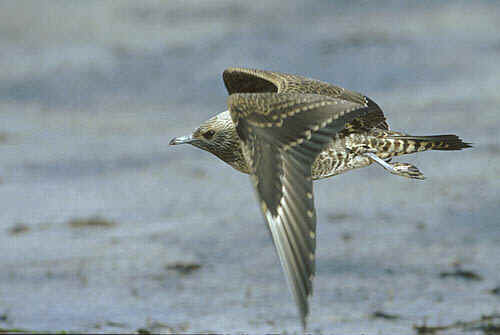
An immature Parasitic Jaeger
(photo by Jens B. Bruun)
- Long-tailed Jaeger (*) (ph) ______ AK:may,jun (PI) CAP:sep
DEP:sep NCP:may,aug
NJP:may,aug,sep WAP:sep
Stercorarius longicaudus
SUBSPECIES IN NORTH AMERICA:
Stercorarius longicaudus pallescens ______
subspecies in Greenland west to eastern Siberia, migrating to the
subantarctic, southern South America, southern Africa, Australasia
Stercorarius longicaudus
is called Long-tailed Skua in the Old World.
Outside North America, the Long-tailed Jaeger has been seen
during FONT tours in Chile (at sea).
- South Polar Skua (*) (ph) ______
CAP:sep DEP:jun,sep NCP:may,jun,aug NJP:may,aug WAP:sep
Stercorarius
(formerly Catharacta) maccormicki (monotypic)
The South Polar Skua breeds in the Southern Hemisphere.
Outside North America, the South Polar Skua has been seen during
FONT tours, during the spring & summer of the Northern Hemisphere, in the
Canary Islands, Japan, and south of the US the
South Polar Skua has been seen during FONT tours in
Chile.
- Subantarctic Skua (*) ______
(r/NA) NJP:may,aug
Stercorarius antarcticus
Stercoraius antarcticus
has been called Brown Skua.
The Subantarctic Skua breeds in the Southern Hemisphere.
Photos have been taken of some birds
that appear to be this species off the
Mid-Atlantic Coast of North America.
However, the Subantarctic Skua
has been found to hybridize with the South Polar Skua, and so genetic
analysis would help giving a firm ID.
South of the US, the Subantarctic Skua has been seen during FONT
tours in Argentina, Chile (southern).
- Great Skua (*) (ph) ______
NJP:dec
Stercoraius
(formerly Catharacta) skua
(monotypic)
Outside North America, the Great Skua has been seen during
FONT tours in Iceland, Spain (in the winter). More Great
Skuas breed in Iceland than anywhere else in the world.
South of the US, the Great Skua has been seen during FONT tours
in Dominica (at sea in March/April)
GULLS
- Laughing Gull (*) (ph) ______
DE:apr,may,jun
FL:apr MD:apr NC:may,jun,jul,aug TX:mar,apr,may
Leucophaeus
(formerly Larus) atricilla
SUBSPECIES NORTH OF THE CARIBBEAN:
Leucophaeus atricilla megalopterus ______
subspecies from Canada, in the east, south to Peru, migratory
The Laughing Gull was described by Linnaeus in 1758, the
nominate subspecies of the Caribbean.
South of the US, the Laughing Gull has been seen during FONT
tours in Belize, the Cayman Islands, Chile (far-north), Costa Rica,
Dominica, the Dominican Republic, Ecuador, Guatemala,
Honduras, Jamaica, Mexico, Panama, Puerto Rico (with an
obvious seasonal fluctuation in numbers), Saint Lucia, Saint
Vincent, Venezuela.
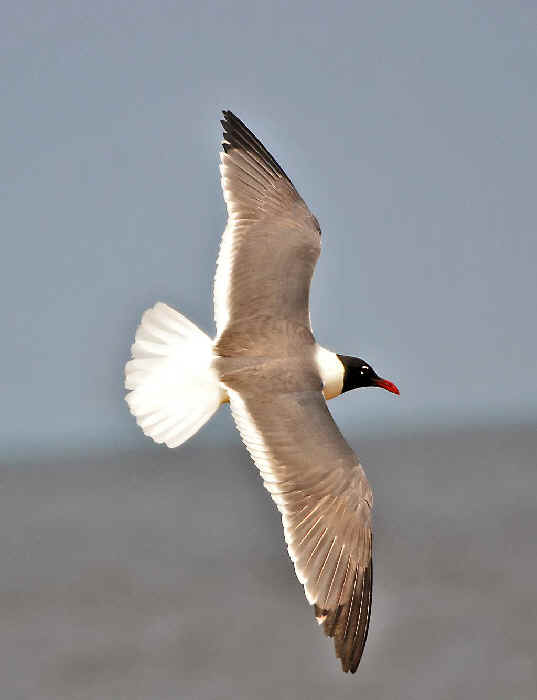
A Laughing Gull in breeding plumage
(photo by Howard Eskin)
- Franklin's Gull (*) (ph) ______
CO:apr
IA:mar KS:apr NE:mar TX:may WA:sep WY:apr
Leucophaeus
(formerly Larus) pipixcan (monotypic)
South of the US, the Franklin's Gull has been seen during FONT
tours in Belize, Chile (mostly at sea), Costa Rica, the
Galapagos Islands (of Ecuador), Guatemala,
Mexico, Panama.
- Bonaparte's Gull (*) (ph) ______
AK:may,jun
BC:sep CA:sep
CO:apr DE:mar,may KS:apr NE:mar TX:mar WA:sep WY:apr
Chroicocephalus
(formerly Larus) philadelphia (monotypic)
South of the US, the Bonaparte's Gull has been seen during a
FONT tour in Mexico (Sonora).
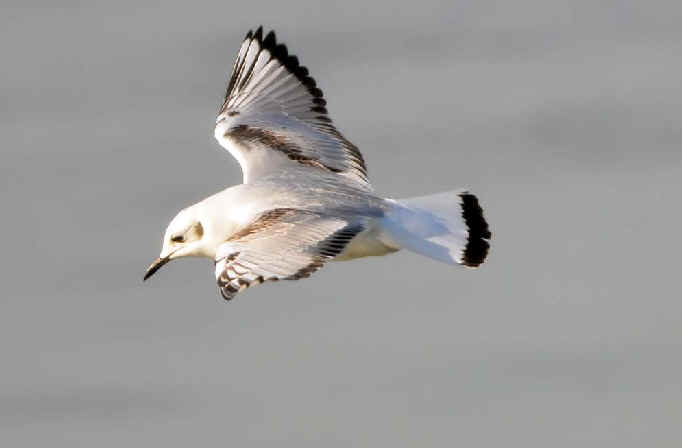
A first-winter Bonaparte's Gull
(photo by Howard Eskin)
- Black-headed Gull (*) (ph) ______
AK:may,jun
(PI) WA:sep
Chroicocephalus
(formerly Larus) ridibudus
(monotypic)
The Black-headed Gull, a common bird of Eurasian and Africa,
was described by Linnaeus in 1766.
A Black-headed Gull was seen in the Puget Sound
area of Washington State during the FONT West Coast Tour in September
2004.
A mostly Old World species. Outside North America, the Black-headed
Gull has been seen during FONT tours in Bulgaria, Hungary, Iceland,
Japan, Poland, Portugal, Romania, Spain, Sweden, Turkey.
- Heermann's Gull (nt) (*) (ph) ______
BC:sep CA:sep WA:sep
Larus heermanni (monotypic)
South of the US, the Heermann's Gull has been seen during
FONT tours in Mexico. The Heermann's Gull is an endemic
Mexican breeder.
- Mew Gull (*) ______ AK:may,jun
(PI) BC:sep WA:sep
Larus canus brachyrhynchus (subspecies in North
America)
In Eurasia, Larus canus is
called the Common Gull.
The two subspecies of Larus canus normally ranging in Eurasia occur rarely in North
America.
The "Kamchatka Gull", L. c. kamtschatschensis,
of eastern Asia, occurs rarely in the Aleutians and on other Alaskan islands.
The European
race, L. c. canus, occurs rarely in northeastern North
America. It is annual in Newfoundland, Canada.
The Common Gull was described by Linnaeus in 1758.
Outside North America, the Common, or Mew, Gull
has been seen during FONT tours in Hungary, Iceland, Japan (the "Kamchatka
Gull"), Poland, Romania, Spain, Sweden.
- Ring-billed Gull (*) (ph) ______
AZ:jul
BC:sep CA:sep
CO:apr,jul DE:mar,apr,may FL:apr (DT) IA:mar MD:apr NC:may,jun,jul,aug NE:mar
NF:jul TX:mar,apr,may VA:mar WA:sep WY:apr
Larus delawarensis (monotypic)
South of the US, the Ring-billed Gull has been seen during
FONT tours in Costa Rica (where rare), Dominica (where rare),
the Dominican Republic, Mexico, Panama, Puerto Rico.
- California Gull (*) (ph) ______ AZ:aug
BC:sep CA:sep
CO:apr,jul
TX:may WA:sep WY:apr
Larus californicus
SUBSPECIES in NORTH AMERICA:
Larus californicus albertaensis ______
subspecies from central Canada and the northwestern US, east of the Rocky
Mountains to non-breeding areas from southwestern Canada to Mexico,
migratory; subspecies described in 1987
Larus californicus californicus ______
subspecies from the northwestern US, south of albertaensis,
to the western US & Mexico, migratory
Away from its breeding & wintering ranges in western North
America, the California Gull also occurs rarely to the east across the continent to
the East Coast and the Gulf Coast in the winter.
South of the US, the California Gull has been seen during a FONT tour
in Mexico (Sonora).
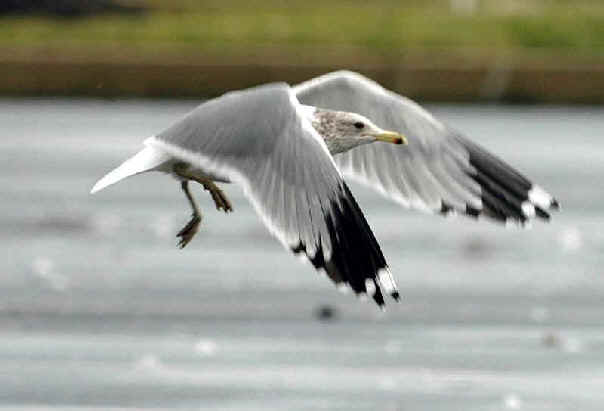
California Gull
(photo by Howard Eskin)
- "American" Herring Gull (*)
______ CA:sep CO:apr
DE:mar,apr,may,sep FL:apr (DT)
IA:mar MD:apr NC:may,jun,jul,aug NE:mar NF:jul TX:mar,apr
VA: mar WA:sep WY:apr
Larus argentatus smithsonianus
A race of the "European" Herring Gull, Larus
argentatus argentaeus, of western Europe (including Iceland &
the Faroe Islands), occurs rarely in Newfoundland, Canada. The nominate, L.
a. argentatus, also ranges in Europe, but generally further
east.
Outside North America, the "European" Herring Gull has been
seen during FONT birding tours in Iceland, Poland, Spain, Sweden, and
south of the US in the Dominican Republic, Mexico (Sonora), Panama,
Puerto Rico.
- Vega Gull (*) (ph) ______ AK;may,jun
(PI)
Larus vegae
Larus vegae, a bird of east
Asia, has been part of the Herring Gull. Outside North America, the Vega Gull has
been seen commonly during FONT tours in Japan.
- Lesser Black-backed Gull (*) (ph)
______
DEP:jun
NJP:may,jun,dec TX:mar
Larus fuscus graellsii (subspecies occurring in
North America)
The Lesser Black-backed Gull is primarily an Old World species of the western Palearctic. But
recently it has become more common, during the non-breeding season, at
certain places in eastern North America, for example, in the US, in Bucks
County, Pennsylvania, where hundreds can occur. It also occurs less commonly
elsewhere in eastern North America, and rarely on the West Coast of the
continent and in Alaska.
Outside North America, the Lesser Black-backed Gull, including the "Baltic
Gull", L. f. fuscus, has been seen during FONT tours
in Bulgaria, Hungary, Iceland ( L. f. graellsii ), Poland, Spain,
Sweden, Turkey.
The population of Lesser Black-backed Gulls in Iceland in the
summer has increased considerably in recent decades.
Further east in Eurasia, the Heuglin's Gull, Larus heuglini,
has been considered as part of the Lesser Black-backed Gull. It has
also been said by some to be conspecific with the Herring Gull, Larus
argentatus.
Outside North America, the Heuglin's Gull has been seen during FONT
tours in Japan.
South of the US, the Lesser Black-backed Gull has been seen
during FONT tours in Dominica (where rare), the Dominican
Republic, Guatemala (where rare), Mexico (the Yucatan), Panama
(where rare), Puerto Rico (where on occasion surprisingly common,
but local).
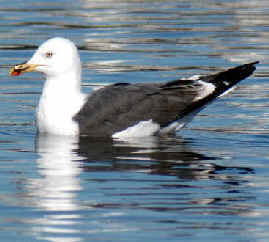
Lesser Black-backed Gull, an adult
(photo by Howard Eskin)
- Great Black-backed Gull (*) (ph)
______ DE:mar,apr,may,jun,sep
NC:may,jun,jul,aug NF:jul NJP:may,jul,aug,sep,nov,dec
VA:mar
Larus marinus
(monotypic)
The Great Black-backed Gull was described by Linnaeus in 1758.
Outside North America, the Great Black-backed Gull has
been seen during FONT tours in Iceland, Poland, Spain, Sweden.
South of the US, the Great Black-backed Gull has been seen during
FONT tours in Puerto Rico (where rare).
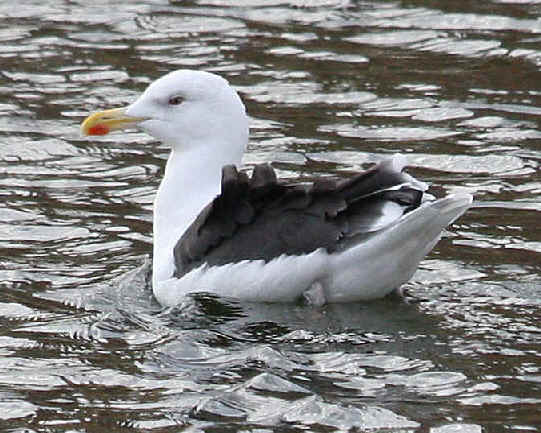
Great Black-backed Gull - the largest gull in the world
(photo by Doris Potter)
- Slaty-backed Gull (*) (ph) ______
(r/NA) AK:may,jun (PI)
Larus schistisagus (monotypic)
The Slaty-backed Gull is an east Asian species. It occurs rarely in coastal Alaska, most often in
the Bering Sea area. Also it occurs rarely in the winter south along the
Pacific Coast of North America, and more rarely elsewhere across the
continent, with sightings recently in Colorado, Florida, Massachusetts,
Minnesota, Missouri, Newfoundland, Ontario, Pennsylvania, Wisconsin. Maybe
due to better coverage in bird guidebooks, there has, during the decade
2000-10, been an increase in sightings across North America.
Outside North America, the Slaty-backed Gull has been seen during
FONT tours in Japan, and especially in Hokkaido where the bird
is very common in the winter.
- Iceland Gull (*) (ph) ______
NJP:dec
Larus glaucoides kumlieni (subspecies in North America)
The other subspecies of the Iceland Gull, L. g. glaucoides,
occurs rarely in northeast North America.
Outside North America, the Iceland Gull has been seen during a FONT
tour in Japan on Hokkaido (where rare).
Also during FONT tours, the Iceland Gull has been seen in Iceland,
where the bird is a non-breeding visitor. They breed in Greenland, and they
are a different subspecies than the Iceland Gulls of most of
North America. Those in Iceland, L. g. glaucoides..
The prevalent Iceland Gull of North America, Larus g. kumlieni,
has been referred to as the "Kumlien's Gull", which has
been said by some to be a hybrid between L. g. glauciodes
and the Thayer's Gull.
- Glaucous Gull (*) (ph) ______ AK:may,jun
(ac) (PI) BC:sep NJP:dec TX:may
Larus hyperboreus
SUBSPECIES IN NORTH AMERICA:
Larus hyperboreus barrovianus ______ subspecies
from Alaska to western Canada
Larus hyperboreus leuceretes ______ subspecies
breeding, east of Barrovianus, in northern Canada, Greenland, Iceland
Outside North America, the Glaucous Gull has been seen
during FONT tours in Iceland, Japan (especially in Hokkaido
where the bird is common in the winter).
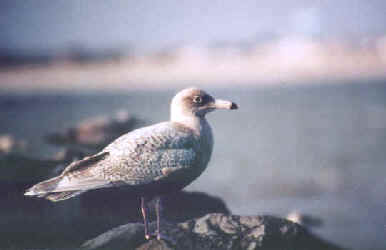
An immature Glaucous Gull
- Glaucous-winged Gull (*) ______ AK:may,jun (PI)
BC:sep CA:sep WA:sep
Larus glaucescens (monotypic)
Outside North America, the Glaucous-winged Gull has been seen
during FONT tours in Japan.
- Western Gull (*) ______ CA:sep
BC:sep WA:sep
Larus occidentalis
SUBSPECIES:
Larus occidentalis occidentalis ______
subspecies in the western US
Larus occidentalis wymanii ______ subspecies
from central California south into Baja California, Mexico
- Little Gull (ph) ______
Hydrocoloeus
(formerly Larus) minutus (monotypic)
Mostly a species of the western Palearctic in the Old World, but in
North America the Little Gull has bred irregularly in Canada from the Great Lakes to the
Hudson Bay. It occurs rarely in the area of the Great Lakes in migration, and
along the East Coast of the US in the winter. It has occurred more rarely
elsewhere in North America.
Outside North America, the Little Gull has been seen during FONT tours in
Bulgaria, Hungary, Poland, Romania, Spain, Turkey.
- Black-tailed Gull (ph) ______
(r/NA)
Larus crassirostris (monotypic)
The Black-tailed Gull is an east Asian species, as a breeder nearly endemic to Japan. In North
America, it occurs rarely in coastal Alaska, and more rarely elsewhere
including the California and the East Coast.
Outside North America, the Black-tailed Gull has been seen during
FONT tours in Japan; commonly seen there, most commonly during spring
tours.
- Belcher's Gull ______ (r/US)
Larus belcheri (monotypic)
Larus belcheri
was part of what was the Band-tailed Gull, with the Olrog's
Gull of southeastern South America now distinct.
The Belcher's Gull is normally along the west coast of South America. It has
occurred rarely in California and Florida.
South of the US, the Belcher's Gull has been seen during FONT tours
in Chile.
- Kelp Gull (ph) ______ (r/US)
Larus dominicanus dominicanus (there is another subspecies
in southern Africa)
At various places in the Southern Hemisphere, Larus
dominicanus is called the Dominican Gull.
The Kelp Gull is a widespread & common circumpolar species of the Southern
Hemisphere. It has occurred rarely along the Gulf Coast of the US. A few
nested on Chandeleur Island, southeast Louisiana, for about a decade
starting in the early 1990s. This resulted in some pure Kelp pairings,
and some mixed pairings with Herring Gulls that produced hybrids.
In Texas, an adult was found at Galveston in January 1996, remaining there
until April.
The species has occurred more rarely elsewhere in North America, including a
bird present multiple-winters in Maryland, and another bird in Indiana.
Additionally, in the Northern Hemisphere, there have been occurrences in
Mexico along the coast of the Yucatan Peninsula, starting in 1993, and in
northern Tamaulipas.
South of the US, the Kelp Gull has been seen during FONT tours in
Argentina, Brazil, Chile, Ecuador, Uruguay.
- Yellow-legged Gull (ph) ______
(r/NA)
Larus michahellis atlantis ______ subspecies that
occurs on the North Atlantic islands of the Azores, Madeira, and the
Canary Islands
The Yellow-legged Gull is an Old World species. It has been conspecific with what is now the Caspian
Gull, Larus cachinnans. Further east in Eurasia, the now Mongolian
Gull, Larus mongolicus, has also been conspecific.
The Yellow-legged Gull occurs rarely along the East Coast of North
America, from Newfoundland south to the mid-Atlantic states of the US.
Outside North America, the Yellow-legged Gull has been seen
during FONT tours in the Canary Islands, Spain.
Also outside North America, the Caspian Gull has been seen during
FONT tours in Bulgaria, Hungary, Romania, Sweden (where rare), Turkey.
The Mongolian Gull has been seen during FONT tours outside North
America in Japan.
- Yellow-footed Gull (ph) ______
Larus livens (monotypic)
The Yellow-footed Gull is restricted to the area of the Gulf of
California (or the Sea of Cortez), mostly in Mexico.
To the south of the US, the Yellow-footed Gull has been seen
during FONT tours in Mexico (Sonora).

Above & below: Yellow-footed Gulls
The above photo was taken during the FONT tour in Sonora, Mexico in
September 2010.
(upper photo by Marie Gardner; lower photo by Abram Fleishman)
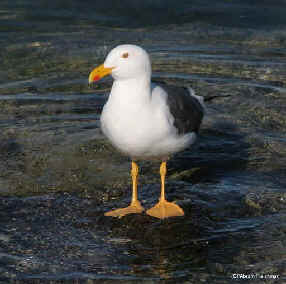
- Thayer's Gull ______
Larus thayeri
(monotypic)
The Thayer's Gull has a confused and controversial taxonomy. It has on
occasion been treated as a subspecies of both the Herring Gull and
the Iceland Gull. With the Iceland Gull, it hybridizes.
Identification of the Thayer's Gull can be
difficult.
Outside North America, the Thayer's Gull has been seen during FONT
tours in Japan in the winter. The species is rare there.
South of the US, a bird appearing to be Thayer's Gull was seen
once during a FONT tour in Mexico (along the Pacific coast).
- Gray-hooded Gull (ph) ______ (r/NA)
Chroicocephalus
(formerly Larus) cirrocephalus
cirrocephalus (subspecies in South America, another is in
Africa)
The Gray-hooded Gull is a species of southern South America & Africa. An adult was photographed
at Apalachicola, Florida on December 26, 1998.
South of the US, the Gray-hooded Gull has been seen during
FONT tours in Argentina, Brazil (Rio Grande do Sul), Ecuador.
- Ivory Gull (*) (ph) ______ AK:may,jun
Pagophila eburnea
(monotypic, and the single member of its genus)
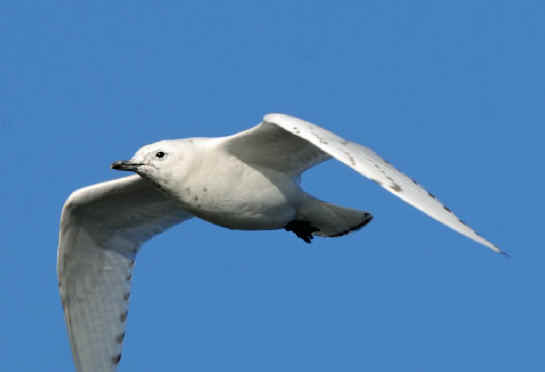
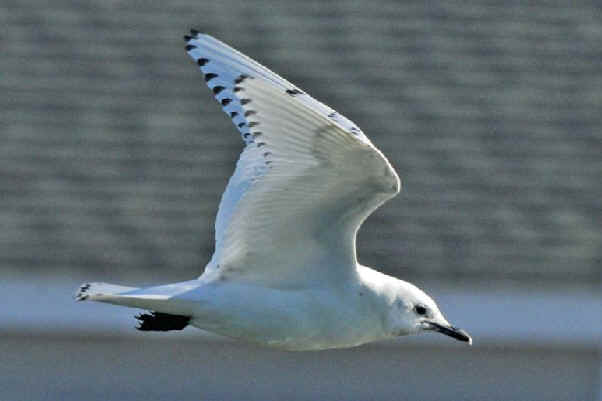
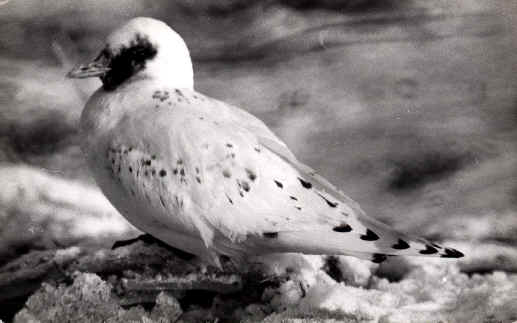
ABOVE: 3 photographs of immature Ivory Gulls
(the top and middle photos by Howard Eskin in
2009; the bottom photo by Alan Brady in 1975)
- Ross's Gull (*) (ph) ______ AK:may,jun
(PI)
Rhodostethia rosea
(monotypic, and the single member of its genus)
Outside North America, the Ross's Gull has been seen during
FONT tours in Japan (where rare in the winter).
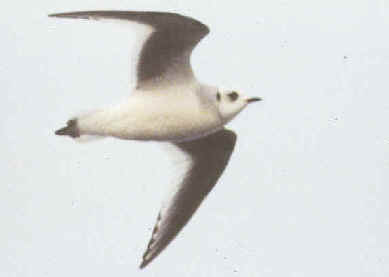
ABOVE & BELOW; Two photos of Ross's Gulls
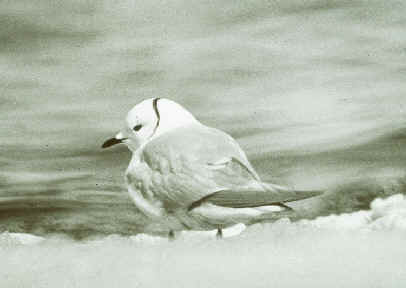
- Sabine's Gull (*) (ph) ______ AK:may,jun (PI) CAP:sep WAP:sep
Xema sabini
(monotypic, and the single member of its genus)
Outside North America, the Sabine's Gull has been seen
during FONT tours in Chile (at sea), Iceland (where rare), Sweden (where
rare).
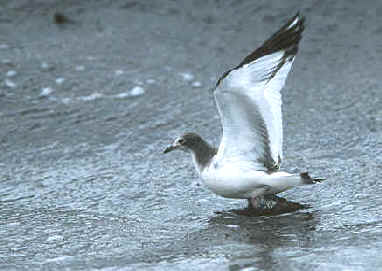
A juvenile Sabine's Gull
(photo by Jens Bruun)
- Black-legged Kittiwake (*) (ph) ______ AK:may,jun (PI)
NJP:may,nov,dec WAP:sep
Rissa tridactyla (monotypic)
The Black-legged Kittiwake was described by Linnaeus
in 1758.
Outside North America, the Black-legged Kittiwake has been
seen during FONT tours in Iceland (at nesting sites), Japan
(mostly at sea), Sweden (an uncommon migrant).
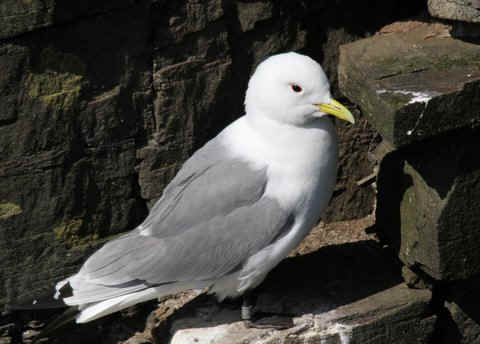
A Black-legged Kittiwake photographed during a
FONT tour
(photo by Gabi Hauser)
- Red-legged Kittiwake (t3) (*) (ph)
______ AK:may,jun (PI)
Rissa revirostris (monotypic)
In the mid-1970s, the total population of the Red-legged Kittiwake
was estimated at about 260,000 individuals. It declined to about 168,000 by
the mid-1990s. Much of this decline was in the Pribilof Islands of
Alaska.

A Red-legged Kittiwake during a FONT Tour in Alaska
TERNS
- Gull-billed Tern (*) (ph) ______
NC:may,jun,jul,aug
TX:apr,may
Gelochelidon
(formerly Sterna) nilotica
SUBSPECIES IN NORTH AMERICA:
Gelochelidon nilotica aranea ______
subspecies in the eastern and southern US and the Bahamas and Cuba,
migrating south to Peru & Brazil
Gelochelidon nilotica vanrossemi ______
subspecies from southern California and northwestern Mexico, migrating
south to Ecuador
Outside North America, the Gull-billed Tern has been
seen during FONT tours in Bulgaria, Japan (on Okinawa),
Spain, Turkey, and south of the US in Argentina, Belize, Costa Rica, the
Dominican Republic, Ecuador, Guatemala, Honduras, Mexico, Panama, Venezuela.
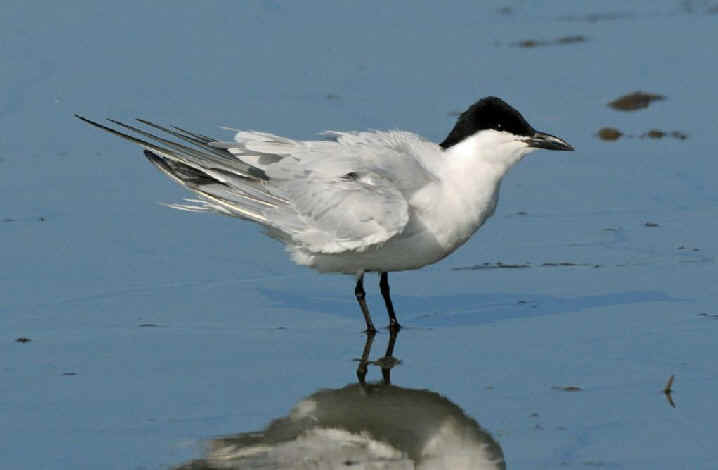
Gull-billed Tern
(photo by Howard Eskin)
- Caspian Tern (*) (ph) ______
BC:sep
CA:sep
CO:jul DE:mar,may MD:apr NC:jun,jul,aug TX:apr,may
WA:sep
Hydroprogne
(formerly Sterna) caspia (monotypic)
Outside North America, the Caspian Tern has been seen
during FONT tours in Bulgaria, Spain, Turkey. Some of those birds may
have made their way to the Caspian Sea.
South of the US, the Caspian Tern has been seen during FONT tours in Belize,
Costa Rica, the Dominican Republic, Guatemala, Honduras, Mexico,
Panama, Puerto Rico.
- Royal Tern (*) (ph) ______
CA:sep
(r/CA) DEP:may,jun FL:apr (DT) NC:may,jun,jul,aug
TX:mar,apr,may
Thalasseus
(formerly Sterna) m. maxima
(subspecies in North America, another subspecies in Africa)
South of the US, the Royal Tern has been seen during FONT
tours in Argentina, Belize, Brazil, the Cayman Islands, Costa Rica, Dominica, the
Dominican Republic, Ecuador, Guatemala, Honduras, Jamaica, Mexico, Panama, Puerto
Rico, Saint Lucia, Saint Vincent, Venezuela.
- Elegant Tern (nt) (*) (ph) ______ AZ:jul
(r/AZ) CA:sep
Thalasseus
(formerly Sterna) elegans (monotypic)
South of the US, the Elegant Tern has been seen in Chile,
Mexico (Sonora).
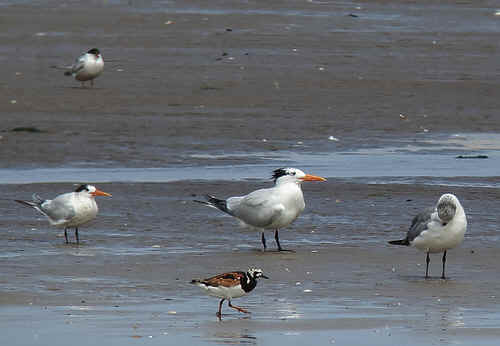
Most Elegant Terns in North America are along the
Pacific Coast.
Here is one along the Atlantic, in New Jersey, in August 2012.
With a Royal Tern for comparison,
the left-most bird was the first Elegant Tern in New Jersey.
(photo by Peter Burke, the finder of this Elegant Tern)
- Sandwich Tern (*) (ph) ______
FL:apr
(DT) NC:may,jun,jul,aug TX:apr,may
Thalasseus
(formerly Sterna) sandvicensis
SUBSPECIES IN NORTH AMERICA:
Thalasseus sandvicensis acuflavida
______ subspecies from eastern North America to the
southern Caribbean, migrating to South America
Outside North America, the Sandwich Tern has been seen during
FONT tours in Bulgaria, Spain, Sweden, Turkey, and south of the US in
Belize, Chile (where rare; far-north), Costa Rica, the
Dominican Republic, Ecuador, Guatemala,
Honduras, Jamaica, Mexico, Panama, Puerto Rico, Saint Lucia.
The Cayenne Tern, Thalasseus eurygnatha, of
mostly coastal South America, has been said to be conspecific with the Sandwich
Tern. South of the US, the
Cayenne Tern
ahs been seen during FONT tours in Argentina, Brazil, Puerto Rico (where rare).
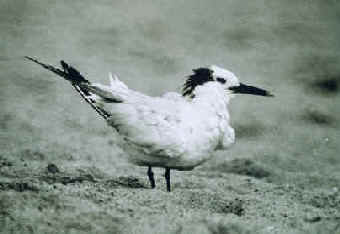
Sandwich Tern
(a black-and-white photo by Alan Brady)
- Common Tern (*) ______ AK:jun
(PI) BC:sep CA:sep DEP:may,jun NC:may,jun,jul,aug
TX:mar,may WA:sep
Sterna hirundo
SUBSPECIES IN NORTH AMERICA:
Sterna hirundo hirundo ______ subspecies from North
America to
northern South America, and in Europe, northern and western Africa, and
western Asia, migrating to south of the Tropic of Capricorn
The Common Tern was described by Linnaeus in 1758.
Outside North America, the Common Tern has been seen
during FONT tours in Bulgaria, Hungary, Japan (the subspecies S.
h. longipennis), Poland, Spain, Sweden, Turkey, and south of
the US in Argentina, Belize, Brazil, Chile, the Dominican Republic,
Ecuador, Honduras, Mexico,
Panama, Puerto Rico.
- Forster's Tern (*) (ph) ______
AZ:jul
CA:sep
CO:apr,jul DE:mar,apr,may DEP:jun MD:apr NC:may,jun,jul,aug NE:apr
TX:mar,apr,may WA:sep
Sterna forsteri (monotypic)
What is now Sterna forsteri was historically named by John James Audubon after an
acquaintance. He called it "Havell's Tern" in honor of his
engraver, the Englishman, Robert Havell, Jr.
For years since, however, it has been with the name, instead, of another
man, Johann Reinhold Forster, who traveled around the world with Captain
Cook in 1772.
South of the US, the Forster's Tern has been seen during FONT tours
in Belize, Mexico, Panama.
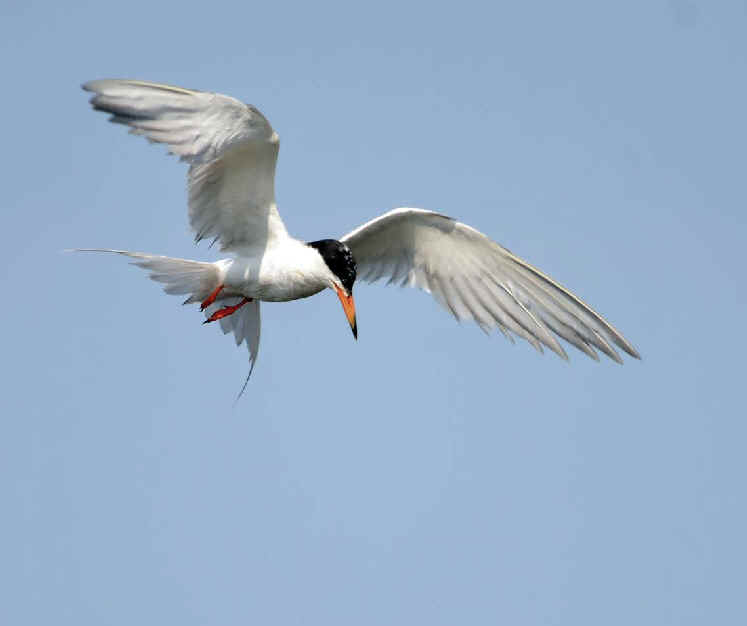
Above and below: Forster's Terns
Above, in breeding plumage; below, non-breeding.
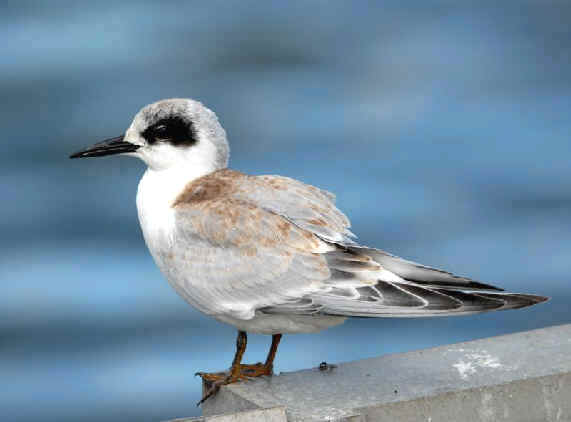
And below: two Forster's Tern fledglings
(all 3 of these photos by Howard Eskin)
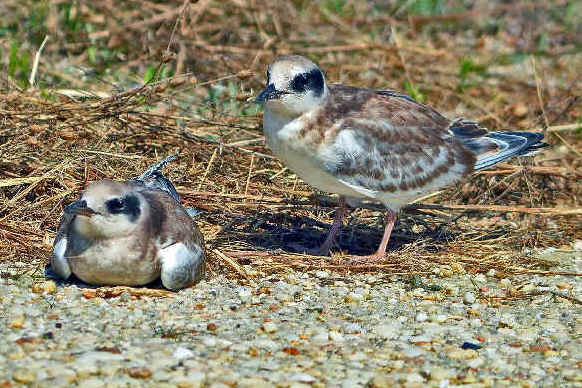
- Roseate Tern (*) (ph) ______
FL:apr (DT)
Sterna dougallii
SUBSPECIES IN NORTH AMERICA:
Sterna dougallii dougallii ______ subspecies
from eastern North America to Venezuela; also in Europe and Africa
The population of the Roseate Tern in eastern North America has
been classified as endangered.
Outside North America, the Roseate Tern has been seen during FONT
tours in Japan, and south of the US in the Dominican Republic,
Mexico, Puerto Rico, Saint Lucia, Venezuela.
- Arctic Tern (*) ______ AK:may,jun
(PI) CAP:sep NC:jun NCP:may,jun NJP:may,sep WAP:sep
Sterna paradisaea (monotypic)
During a FONT North Carolina Tour in June 1996, a couple birds of
the sea were seen on a beach. One of them was a Wilson's Storm Petrel, seen
closely as it rested, before it flew back out over the ocean. The other was
an Arctic Tern, seen on the same beach at the same time.
Outside North America, the Arctic Tern has been seen during FONT
tours in Chile (mostly at sea), Iceland (where it is a very common breeder), Sweden
(as a migrant).
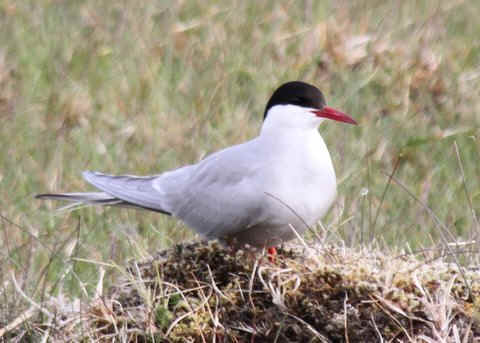
An Arctic Tern photographed during a FONT tour
(photo by Gabriel Hauser)
- Least Tern (*) ______ DE:may
FL:apr MD:apr NC:may,jun,jul,aug NJP:may TX:apr,may
Sternula
(formerly Sterna) antillarum
SUBSPECIES IN NORTH AMERICA:
Sternula antillarum antillarum ______ subspecies
in the eastern and southern US and south to northern Brazil, migratory
Sternula antillarum athalassos ______ subspecies
from central North America and south to northern Brazil, migratory
Sternula antillarum browni ______ subspecies
from central California to western Mexico and south to Central America,
migratory
South of the US, the Least Tern has been seen during FONT
tours in the Cayman Islands, the Dominican Republic, Mexico,
Puerto Rico. Least Terns that breed on Caribbean islands spend
their non-breeding season further south.
- Aleutian Tern (*) ______ AK:may,jun
Onychoprion (formerly Sterna)
aleutica (monotypic)
- Bridled Tern (*) (ph) ______
DEP:jun,sep
FL:apr
(DT) NCP:may,jun,jul,aug NJP:aug,sep
Onychopion
(formerly Sterna) anaethetus
SUBSPECIES IN NORTH AMERICAN WATERS:
Onychopion anaethetus melanoptera ______
subspecies in the Caribbean Sea; also west Africa
South of the US, the Bridled Tern has been seen during FONT
tours in Puerto Rico (at sea), Saint Lucia.
- Sooty Tern (*) (ph) ______
FL:apr
(DT) NC:aug NCP:aug
Onychopion
(formerly Sterna) fuscata
SUBSPECIES IN NORTH AMERICAN WATERS:
Onychopion fuscata fuscata ______ subspecies
in the Gulf of Mexico and the West Indies, to the South Atlantic Ocean,
migratory
The Sooty Tern was described by Linnaeus in 1766.
During a FONT North Carolina Tour in August 1994, a Sooty Tern was seen in
flight over the Outer Banks, not far from Cape Hatteras where a pair nested
that year in a colony of other tern species.
The previous summer, all-dark juvenile Sooty Terns were seen during a FONT
NC pelagic trip in August 1993.
South of the US, the Sooty Tern has been seen during FONT tours
in Dominica (at sea), Puerto Rico, Saint Lucia.
- Black Tern (*) (ph) ______
AZ:jul,aug,sep
CA:sep CO:jul DEP:sep NC:aug NCP:aug NJP:aug,sep WA:sep
Chlidonias niger
SUBSPECIES IN NORTH AMERICA:
Chlidonias niger surinamensis ______ subspecies
from Canada and the northern US to Central America and northern South
America, migratory
The Black Tern was described by Linnaeus in 1758.
Outside North America, the European race of the Black Tern, C.
n. niger, has been seen during FONT tours in Bulgaria, Hungary,
Poland, Romania, Spain,
South of the US, the Black Tern, C. n. surinamensis, has
been seen during FONT tours in Belize, the Dominican Republic, Guatemala.
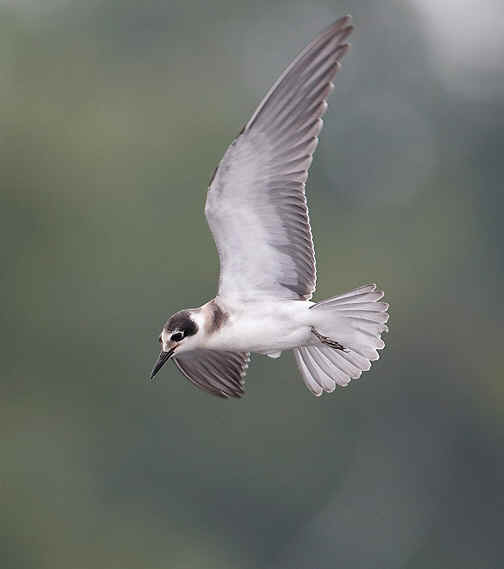
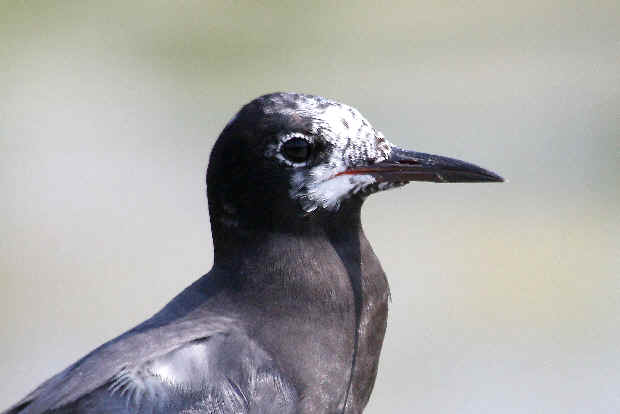
Two photographs of Black Terns
(upper photo by Kim Steininger; lower photo
by Doris Potter)
- White-winged Tern (*) (ph) ______
(r/NA)
CA:sep
Chlidonias leucopterus (monotypic)
The White-winged Tern is a Eurasian species. In North America, it occurred as a rarity along the East
Coast, in the area of the Great Lakes, and once further north at Churchill, and along the West
Coast, from Alaska to California.
Along the East Coast, there were, in the 1970s, 1980s, and 1990s, a
number of occurrences in Delaware:
in Jul-Sep 1974, Jul 1978, the
summer of 1988, and Jul-Sep 1993. In 1993, there were at least 2 birds
present.
All of these birds in Delaware were in the same area of
marshes (from Port Mahon to Little Creek).
Elsewhere in the East, the White-winged Tern has been in New
Jersey (in 1989) and Virginia (in 2002).
In all, as of 2014, there have been from 20 to 30 records of the White-winged
Tern in eastern North America.
In the interior of North America, including the Great Lakes area,
there have been White-winged Tern records in the US in Indiana (in
1979), and in Canada in southwestern Ontario in May 1991 and May 1992 (maybe
the same bird), and in Churchill, Manitoba in Jun-Jul
1995.
.
Along the
Pacific Coast, there have been occurrences in the western Aleutian Islands
of Alaska, in south-coastal Alaska, and in coastal
California.
In Alaska, there have been 3 records in the western and central
Aleutian Islands from mid-May to mid-Jul, in the Pribilof Islands (in Jun
2004), and on the Alaskan mainland, in central AK in Jul 2003 and
south-coastal AK in Aug-Sep 1992.
In California, there have been occurrences in Humboldt County Jun-Aug
1996 and in the Monterey area Sep-Oct 1999.
A single White-winged Tern was seen in
California during the FONT West Coast Tour in September 1999,
noted above as being in the Monterey area.
Outside North America, the White-winged Tern has been seen during
FONT tours in Bulgaria, Hungary, Poland, Turkey.
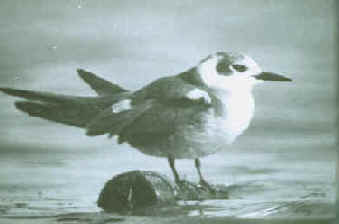

Two photographs
of a White-winged Tern, taken in Delaware.
(photos by
Alan Brady)
- Whiskered Tern (ph) ______ (r/US)
Chlidonias hybridus (3 subspecies in Europe, Asia, Africa,
Australia)
The Whiskered Tern is a species of the Old World, where it is widespread.
In North America,
there were records of adult birds in the mid-1990s and, later, one in 2014.
In 1993, one was at Cape May, New Jersey, from July 12 to 15. That bird
moved to nearby Delaware where it was present from July 19 to August 24.
Another occurrence was at Cape May, August 8 to 12, 1998.
More recently, and again at Cape May, New Jersey, a
Whiskered Tern was seen September 12 to 20, 2014.
Outside North America, the Whiskered Tern has been
seen during FONT tours in Bulgaria, Hungary, Japan, Poland, Romania,
Spain, Turkey.
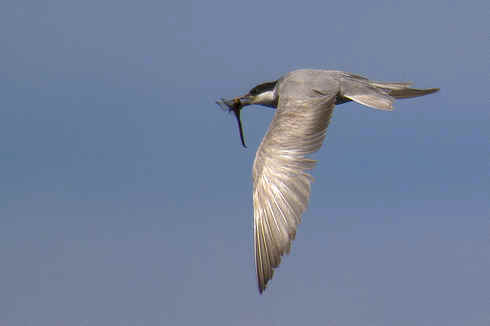
The Whiskered Tern at Cape May, New Jersey in
September 2014, with a dragonfly
(photo by Leroy Tabb)
- Large-billed Tern (ph) ______
(r/US)
Phaetusa simplex (2 subspecies in of South America)
In South America, the Large-billed Tern is normally at freshwater
habitats. In North America, it
has occurred as a rarity in Illinois, Ohio, and New Jersey. It has also
occurred out-of-range in Bermuda and Cuba.
South of the US, the Large-billed Tern has been seen during FONT
tours in Argentina, Brazil, Ecuador, Venezuela.
- Brown Noddy (*) ______
FL:apr (DT)
Anous stolidus
SUBSPECIES IN NORTH AMERICA:
Anous stolidus stolidus ______ subspecies in the
Caribbean and the tropical Atlantic Ocean
The Brown Noddy was described by Linnaeus in 1758.
South of the US, the Brown Noddy has been seen during FONT tours
in the Galapagos Islands (of Ecuador), Puerto Rico, Saint Lucia.
- Black Noddy ______ (r/US)
Anous minutus
SUBSPECIES THAT OCCURS IN NORTH AMERICA:
Anous minutus americanus ______ subspecies
in the Caribbean
The Black Noddy is a species of tropical oceans. It has occurred rarely, and irregularly,
with Brown Noddies, at the Dry Tortugas in Florida. Black Noddies
at the Dry Tortugas have been mostly immature birds. The species has also
occurred rarely along the Texas Gulf Coast.
SKIMMER
- Black Skimmer (*) (ph) ______
DE:may
FL:apr NC:may,jun,jul,aug TX:mar,may
Rynchops niger
SUBSPECIES IN NORTH AMERICA:
Rynchops niger niger ______ subspecies of the
coastal US and Mexico, south to Central America
The Black Skimmer was described by Linnaeus in 1758.
South of the US, the Black Skimmer has been seen during
FONT tours in Argentina, Bolivia, Brazil, Chile, Costa Rica, Ecuador, Guatemala (where rare), Honduras,
Mexico, Venezuela.
Black Skimmers in North & South
America are different
populations that do not meet.
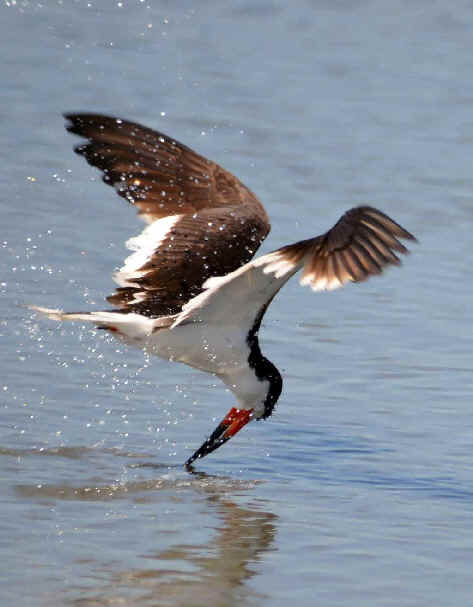
Above & below: Black Skimmers
In the middle photo, a juvenile.
In the bottom photo: an adult skimming
(all these photos by Howard Eskin)
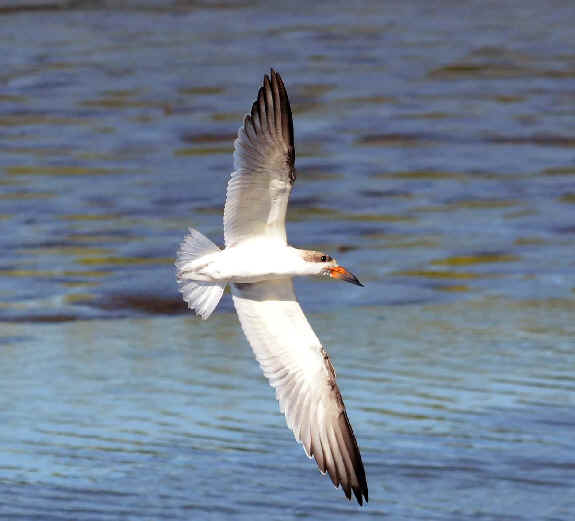
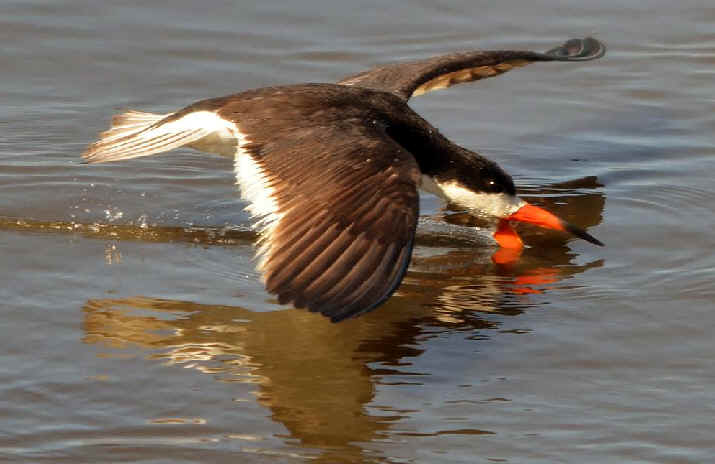
ALCIDS
- Common Murre (*) (ph) ______
AK:may,jun (PI)
BC:sep CA:sep CAP:sep NF:jul NJP:dec WA:sep WAP:sep
Uria aalage
SUBSPECIES IN NORTH AMERICA:
Uria aalage aalage ______ subspecies in and around the North Atlantic, breeding south to eastern Canada and Scotland
and Norway
Uria aalage californica ______ subspecies from
Washington State to California
Uria aalage inornata ______ subspecies from the
Bering Sea and western Alaska to southwestern Canada
Uria aalage is called Guillemot
in Europe.
Outside North America, the Common Murre, or Guillemot, has
been seen during FONT tours in Iceland (where it breeds), Japan
(mostly at sea), Sweden.
- Thick-billed Murre (*) (ph) ______
AK:may,jun (PI)
NF:jul NJP:dec
Uria lomvia
SUBSPECIES IN NORTH AMERICA:
Uria lomvia lomvia ______
subspecies in the North Atlantic Ocean
Uria lomvia arra ______ subspecies in the North
Pacific Ocean, including western and southern Alaska and the Aleutian
Islands
Uria lomvia is called Brunnich's
Guillemot in Europe. It was described by Linnaeus in
1758.
Outside North America, the Thick-billed Murre, or Brunnich's
Gullemot, has been seen during FONT tours in Iceland (where it
breeds), Japan (mostly at sea).
- Razorbill (*) (ph) ______
NF:jul NJP:nov,dec
Alca torda
SUBSPECIES IN NORTH AMERICA:
Alca torda torda ______ subspecies in eastern
North America and Greenland east to northern Scandinavia
The Razorbill was described by Linnaeus in 1758.
Outside North America, the Razorbill has been seen during FONT
tours in Iceland (where it breeds), Spain (in winter).

A Razorbill photographed during a FONT tour
(photo by Gabi Hauser)
- Black Guillemot (*) (ph) ______
AK:jun
NF:jul
Cepphus grylle
SUBSPECIES IN NORTH AMERICA:
Cepphus grylle articus ______ subspecies in the
northeastern US, southeastern Canada, and southern Greenland, east to Europe
Cepphus grylle mandtii ______ subspecies further
north than C. g. articus, in
northeastern Canada, northern Greenland, and northern Alaska and northern
Siberia
The Black Guillemot was described by Linnaeus in 1758, the
nominate subspecies in the area of the Baltic Sea.
Outside North America, the Black Guillemot has been seen during
FONT tours in Iceland.
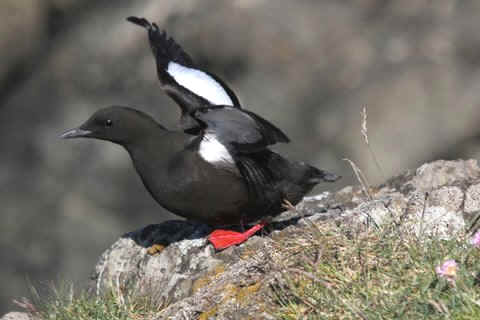
Above & below: Black Guillemots photographed during
FONT
tours.
Above, in breeding plumage; below, non-breeding plumage
(upper photo by Gabi Hauser; lower photo by Alan Mitchnick)
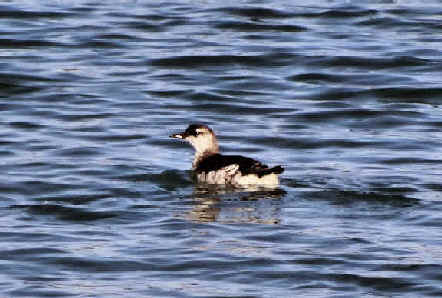
- Pigeon Guillemot (*) ______ AK:may,jun (PI)
BC:sep CA:sep CAP:sep WA:sep
Cepphus columba
SUBSPECIES IN NORTH AMERICA:
Cepphus columba columba ______ subspecies from
the Bering Sea and western and southern Alaska to the western US, with
some migrating further south to northwestern Mexico
Cepphus columba kaiurka ______ subspecies in Alaska in the
western Aleutian Islands
Outside North America, the Pigeon Guillemot has been seen during
FONT tours in Japan (at sea).
- Dovekie (*) ______ AK:jun
NJP:dec
Alle alle
SUBSPECIES THAT OCCUR IN NORTH AMERICA:
Alle alle alle ______ subspecies in the North
Atlantic Ocean
Alle alle polaris ______ subspecies in the
Barents Sea
Alle alle is called Little
Auk in the Old World. It was described by Linnaeus in 1758.
- Marbled Murrelet (t2) (*) ______ AK:may,jun (PI)
BC:sep CA:sep CAP:sep WAP:sep
Brachyramphus marmoratus
(monotypic)
For more about the Marbled Murrelet, and the Kittliz's Murrelet, go to:
RARE & THREATENED BIRDS OF NORTH AMERICA
- Kittlitz's Murrelet (t1) (*) ______ AK:may,jun
Brachyramphus brevorostris (monotypic)
- Long-billed Murrelet (nt) ______
(r/NA)
Brachyramphus perdix
The Long-billed Murrelet is a species of coastal northeast Asia. It occurs rarely, and seemingly
without any pattern, throughout North America, with most occurrences in the
fall of birds in winter-plumage.
Outside North America, the Long-billed Murrelet has been seen during
FONT tours in Japan (mostly at sea).
- Ancient Murrelet (*) ______ AK:jun
Synthliboramphus antiquus
SUBSPECIES IN NORTH AMERICA:
Synthliboramphus antiquue antiquus ______ subspecies
in southern Alaska and Queen Charlotte Island; also west to Asia as far
south as Yellow Sea
Outside North America, the Ancient Murrelet has been seen during
FONT tours in Japan, including Hegura Island.
- Scripps's Murrelet (t3) (*) ______
CAP:sep WAP:sep
Synthliboramphus scrippsi (monotypic)
The Scripps's Murrelet and the Guadalupe Murrelet (below)
were part of what was the Xantu's Murrelet.
Synthliboramphus scrippsi
occurs at sea mostly in California. Away from its breeding sites, it occurs
north, rarely, to northern California and more rarely to Oregon and
Washington State, and south to southern Baja California, Mexico.
It breeds on islands off southern California: San Miguel, Santa Cruz,
Anacapa, Santa Barbara, San Clemente, and formerly Santa Catalina, and in
western Baja California, Mexico on San Benito, and Coronado and San Jeronimo
islands. On larger islands (such as San Miguel, Santa Cruz, and San
Clemente), it is confined largely or entirely to offshore rocks.
- Guadalupe Murrelet (t3)
______
Synthliboramphus hypoleucus
(monotypic)
Synthliboramphus hypoleucus breeds in offshore
rocks and islands off western Baja California, Mexico from Guadalupe Island
south to the San Benito Islands. Breeding is unconfirmed on San Martin
Island, in Baja California, and San Clemente and Santa Barbara Islands in
California, USA.
It presumably winters offshore within the breeding range along the Pacific
coast of Baja California.
- Craveri's Murrelet (t3) (*) ______ CA:sep
Synthliboramphus craveri (monotypic)
South of the US, the Craveri's Murrelet has been seen during a
FONT tour in Mexico (Sonora).
- Cassin's Auklet (*) _____ CAP:sep WAP:sep
Ptychormphus aleuticus
SUBSPECIES IN NORTH AMERICA:
Ptychormphus aleuticus aleuticus ______
subspecies from the Aleutian Islands & southern Alaska to
northern Baja California in Mexico. There is another subspecies in
Baja California.
- Rhinoceros Auklet (*) ______ AK:may,jun
BC:sep CAP:sep WA:sep WAP:sep
Cerohinca monocerata (monotypic, and the single member of its genus)
Outside North America, the Rhinoceros Auklet has been
seen during FONT tours in Japan.
- Parakeet Auklet (*) ______ AK:may,jun (PI)
Aethia psittacula (monotypic)
- Least Auklet (*) (ph) ______ AK:may,jun (PI)
Aethia pusilla (monotypic)
Outside North America, the Least Auklet has been seen during FONT
tours in Japan (mostly at sea).

Least Auklet
(photo by Mike Danzenbaker)
- Crested Auklet (*) ______ AK:may,jun (PI)
Aethia cristatella (monotypic)
Outside North America, the Crested Auklet has been seen during
FONT tours in Japan (at sea).
- Whiskered Auklet ______
Aethia pygmaea
(monotypic)
The Whiskered Auklet occurs in the Aleutian Islands of Alaska, and
west to the northeastern Sea of Okhotsk.
- Tufted Puffin (*) ______ AK:may,jun
(PI) WAP:sep
Fratercula cirrhata
Outside North America, the Tufted Puffin has been seen during
FONT tours in Japan (at sea).
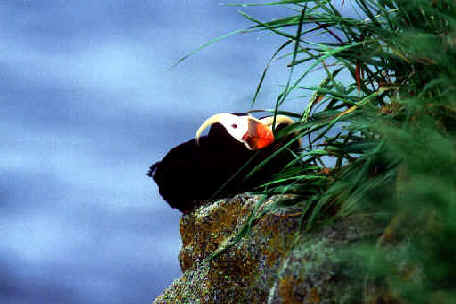
Tufted Puffin
(photo by Paul West during a FONT tour)
- Horned Puffin (*) (ph) ______ AK:may,jun (PI)
Fratercula corniculata
Outside North America, the Horned Puffin has been seen during
FONT tours in Japan (at sea).
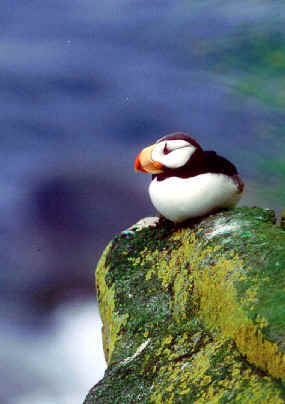
Horned Puffin
(photo by Paul West during a FONT tour)
- Atlantic Puffin (*) (ph) ______ DEP:jun
NF:jul NJP:may,dec
Fratercula arctica
SUBSPECIES IN NORTH AMERICA:
Fratercula arctica arctica ______ subspecies in
the northeastern US and eastern Canada, and east in Greenland, and Iceland
and other places in Europe, migratory
The Atlantic Puffin was described by Linnaeus in
1758.
Outside North America, the Atlantic Puffin has been seen during FONT
tours in Iceland (where it breeds).
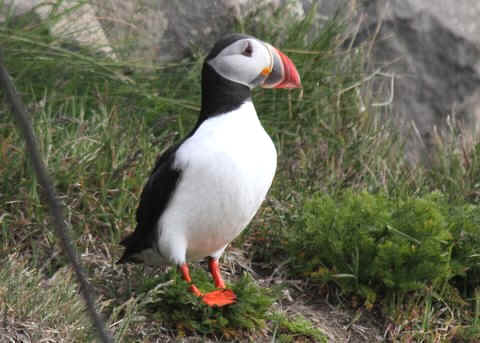
Above & below: Atlantic Puffins photographed during a FONT tour
(photos by Gabi Hauser)
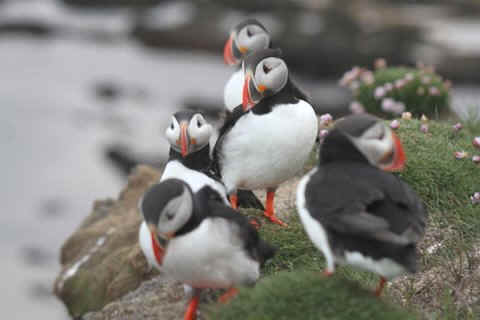
- Great Auk ______ (extinct)
Pinguinus impennis
The Great Auk was described by Linnaeus in 1758. It became extinct
in 1844. In the winter, this flightless bird occurred in North America as
far south as the coastal Carolinas.
Outside North America, during FONT tours in Iceland, the island has
been seen where the last Great Auks lived.
PIGEONS & DOVES
- Common (or Feral) Pigeon
(i) (*) ______
AK:may,jun (ac) AZ:jan,jul,aug,sep BC:sep CA:sep CO:apr,jul
DE:mar,apr,may FL:apr IA:mar KS:apr MD:apr NC:may,jun,jul,aug NE:mar,apr
NF:jul NM:apr,aug OK:apr TX:mar,apr,may VA:mar
WA:sep WY:apr
Columba livia
Outside North America, the Common, or Feral, Pigeon
has been seen during FONT tours in Bulgaria, Hungary, Iceland, Japan, Poland, Romania, Slovakia, Spain, Sweden, Turkey.
Wild Rock Pigeons have been seen during FONT tours in the
Canary Islands, and in parts of Spain.
South of the US, the Common, or Feral, Pigeon
has been seen during FONT tours in Argentina, Belize, Bolivia, Brazil, the Cayman Islands, Chile, Costa Rica,
Dominica, the Dominican Republic, Haiti, Ecuador, Guatemala, Honduras,
Jamaica, Mexico, Panama, Paraguay, Puerto Rico, Saint Lucia, Saint Vincent,
Venezuela.
- Band-tailed Pigeon (*) (ph) ______
AZ:jul,aug,sep
BC:sep CA:sep CO:jul WA:sep
Patagioenas (formerly Columba)
fasciata
SUBSPECIES IN NORTH AMERICA:
Patagioenas fasciata fasciata ______
subspecies from the Rocky Mountains of the western US to Nicaragua
Patagioenas fasciata monilis ______ subspecies
from the Pacific Northwest in the US & nearby Canada south to California
South of the US, the Band-tailed Pigeon has been seen during FONT
tours in Costa Rica, Ecuador, Guatemala, Panama.
- Red-billed Pigeon ______ (r/US)
Patagioenas
(formerly Columba) flavirostris
The Red-billed Pigeon is a Mexican and Central American species. It occurs rarely in south Texas,
less now than formerly.
SUBSPECIES THAT OCCURS NORTH OF MEXICO:
Patagioenas flavirostris flavirostris
______ (subspecies from Texas to Costa Rica)
South of the US, the Red-billed Pigeon has been seen during FONT
tours in Belize, Costa Rica, Guatemala, Honduras, Mexico.
- White-crowned Pigeon (nt) ______
Patagioenas
(formerly Columba) leucocephala
(monotypic)
The White-crowned Pigeon was described by Linnaeus in
1758.
South of the US, the White-crowned Pigeon has been seen during
FONT tours in the Cayman Islands, the Dominican Republic, Jamaica,
Mexico (Cozumel Island), Puerto Rico.
- Scaly-naped Pigeon (ph) ______ (r/US)
Patagioenas
(formerly Columba) squamosa
A common species of West Indian islands. Two old specimens at from
Key West, Florida: August 24, 1898 and May 6, 1929.
South of the US, the Scaly-naped Pigeon has been seen during FONT
tours in Barbados, Dominica, the Dominican Republic, Puerto Rico,
Saint Lucia, Saint Vincent.
- Passenger Pigeon ______ (extinct)
Ectopistes migratorius
- Eurasian Collared Dove (NAi) (*)
______ AZ:jan,jul,aug,sep
CO:apr FL:apr KS:apr NC:aug NE:apr NM:apr
OK:apr TX:mar,apr,may
Streptopelia decaocto
Outside North America, the Eurasian Collared Dove has been
seen during FONT tours in Bulgaria, the Canary Islands, Hungary, Poland,
Portugal, Romania, Slovakia, Spain, Sweden, Turkey.
In Europe, during the last couple decades, this species has had a major
range expansion, spreading west, and with it a large increase in population.
During FONT European tours in the 1990s, for example, in Spain, the species
was not commonly seen as it is now.
South of the US, the Eurasian Collared Dove has been seen during FONT
tours in Dominica, Mexico. As far west as Sonora, the species is now
very common, especially in towns.
- Spotted Dove (NAi) ______
Streptopelia chinensis
- Oriental Turtle Dove ______ (r/NA)
Streptopelia orientalis
An Asian species. In occurs rarely in the Aleutian Islands and the
Bering Sea area of Alaska in the spring and summer. It has occurred more
rarely on Vancouver Island, in British Columbia, Canada, and in
California.
Outside North America, the Oriental Turtle Dove has been seen during
FONT tours in Japan.
- European Turtle Dove ______ (r/US)
Streptopelia turtur
An Old World species that has occurred in Florida, once, the only known
occurrence in North America.
The European Turtle Dove has been seen during FONT tours in Bulgaria,
the Canary Islands, Hungary, Poland, Spain, Turkey.
- White-winged Dove (*) (ph) ______ AZ:jan,jul,aug,sep
CA:sep FL:apr NM:apr TX:mar,apr,may
Zenaida asiatica
SUBSPECIES IN NORTH AMERICA:
Zenaida asiatica asiatica ______ subspecies from
southern US to Nicaragua, also in the West Indies
Zenaida asiatica mearnsi ______ subspecies in
the southwestern US and western Mexico
The White-winged Dove was described by Linnaeus in 1758.
South of the US, the White-winged Dove has been seen during FONT
tours in Belize, the Cayman Islands, Costa Rica, the
Dominican Republic, Guatemala, Honduras, Jamaica, Mexico, Puerto Rico.
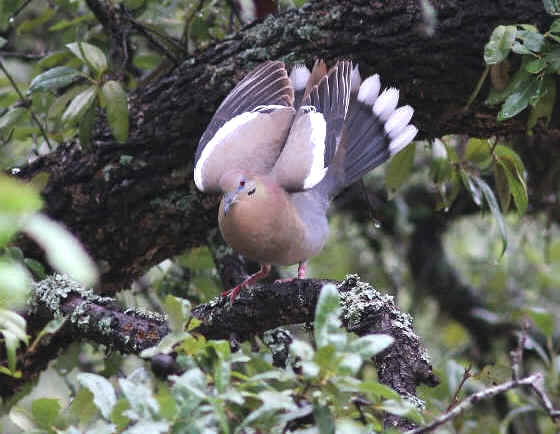
A White-winged Dove
photographed in Texas
(photo by Rhett Poppe)
- Mourning Dove (*) (ph) ______
AZ:jan,jul,aug,sep
CA:sep
CO:apr,jul DE:mar,apr,may FL:apr IA:mar KS:apr
MD:apr NC:may,jun,jul,aug
NE:mar,apr NM:apr,jul,aug OK:apr TX:mar,apr,may
VA:mar WA:sep WY:apr
Zenaida macroura
SUBSPECIES NORTH OF MEXICO & THE CARIBBEAN:
Zenaida macroura carolinesis ______ subspecies
in eastern North America and the Bahamas
Zenaida macroura marginella ______ subspecies
from western North America to central Mexico
The Mourning Dove was described by Linnaeus in 1758, the nominate
subspecies in the West Indies.
South of the US, the Mourning Dove has been seen during
FONT tours Belize, Costa Rica, the Dominican Republic, Guatemala,
Haiti, Honduras, Jamaica, Mexico, Panama, Puerto Rico.
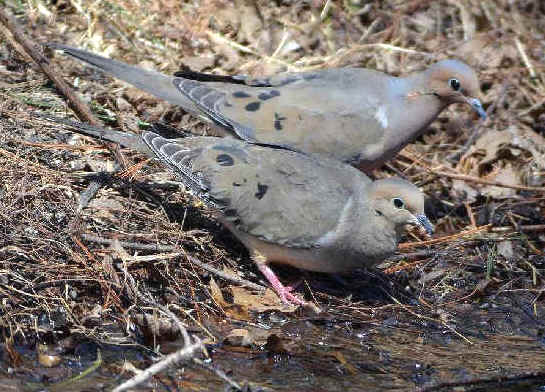
A pair of Mourning Doves
(photo by Howard Eskin)
- Zenaida Dove (ph) ______ (r/US)
Zenaida aurita
The Zenaida Dove is primarily a species of West Indian islands. It has occurred in recent years
as a rarity in the Florida Keys and on the southern Florida mainland.
Historically, it was noted by Audubon as breeding in the Florida Keys in
1832.
South of the US, the Zenaida Dove has been seen during FONT tours in Barbados,
the Cayman islands, Dominica,
the Dominican Republic, Jamaica, Mexico
(Cozumel Island & the nearby Yucatan), Puerto Rico,
Saint Lucia, Saint Vincent.
- Inca Dove (*) (ph) ______ AZ:jul,aug
TX:apr,may
Columbina
(formerly Scardafella) inca
South of the US, the Inca Dove has been seen during FONT tours
in Costa Rica, Guatemala, Honduras, Mexico.
- Common Ground Dove (*) (ph) ______ AZ:jan,jul,aug
FL:apr TX:apr,may
Columbina passerina
South of the US, the Common Ground Dove has been seen
during FONT tours in Barbados, Belize, Brazil, the Cayman Islands, Costa Rica,
Dominica, the Dominican Republic, Ecuador, Guatemala, Honduras, Jamaica,
Mexico, Puerto Rico, Saint Lucia, Saint Vincent, Venezuela.
- Ruddy Ground Dove (ph) ______ (r/US)
Columbina talpacoti
Most US records of the Ruddy Ground Dove are of the west Mexican race eluta. Some Texas records
are of the east Mexican race rufipennis, which as a richer cinnamon
coloration.
South of the US, the Ruddy Ground Dove has been seen during FONT
tours in Argentina, Belize, Bolivia, Brazil, Costa Rica, Ecuador, Guatemala, Honduras, Mexico,
Panama, Paraguay, Venezuela.
- White-tipped Dove (*) ______
TX:may
Leptotila verreauxi
South of the US, the White-tipped Dove has been seen
during FONT tours in Argentina, Belize, Bolivia, Brazil, Costa Rica,
Ecuador, Guatemala, Honduras, Mexico,
Panama, Paraguay, Venezuela.
- Key West Quail Dove ______ (r/US)
Geotrygon chrysia
The Key West Quail Dove is a West Indian species. In 1832, Audubon told of it breeding at Key West,
Florida. That population disappeared by the mid-19th century. Now, it occurs
rarely on the Florida Keys and in south Florida.
South of the US, the Key West Quail Dove has been seen during
FONT tours in the Dominican Republic, Puerto Rico.
- Ruddy Quail Dove ______ (r/US)
Geotrygon montana
The Ruddy Quail Dove is a species of Central & South America and the West Indies. It has
occurred rarely in Florida and in south Texas.
South of the US, the Ruddy Quail-Dove has been seen during FONT tours
in Belize, Brazil, Costa Rica, Dominica, the Dominican Republic,
Ecuador, Guatemala,
Jamaica, Mexico, Puerto Rico, Saint Lucia, Saint Vincent, Venezuela.
PARAKEETS & PARROTS
- Carolina Parakeet ______ (extinct;
it was the only native North American psittacid)
Conuropsis carolinensis
- Rosy-faced Lovebird (NAi) (*) (ph)
______ AZ:sep
Agapornis roseicollis
Agapornis roseicollis
is also called the Peach-faced Lovebird. It is native to
Africa.
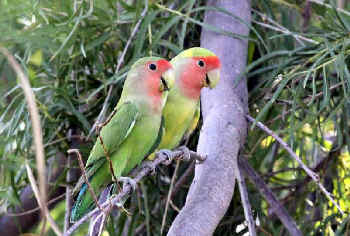
Rosy-faced Lovebirds photographed during a FONT tour in Arizona
(photo by Marie Gardner)
- Monk Parakeet (NAi) (*) (ph) ______ DE:may
TX:may
Myiopsitta monachus
Outside North America, the Monk Parakeet has been seen,
where it is not native, during FONT tours in the Canary Islands, and
in Spain.
South of the US, the Monk Parakeet has been seen during FONT tours in
Argentina (where native), Bolivia (where native), Brazil (where native), the Cayman
Islands (where not native), Puerto Rico (where not native), Uruguay
(where native).
- Green Parakeet (*) ______ TX:may
Aratinga holochlora
South of the US, the Green Parakeet has been seen during
FONT tours in Guatemala.
- Red-masked Parakeet (NAi) (*)
(ph) ______ CA:sep
Aratinga erythrogenys
The native range of the Red-masked Parakeet is in South America,
mostly Ecuador, also Peru.
It occurs in San Francisco, especially near Telegraph Hill, and that's where
we've seen it during our FONT tour in California.
South of the US, the Red-masked Parakeet has been seen during
FONT tours in Ecuador (where native).

A Red-masked Parakeet photographed during a FONT
tour in Ecuador
(photo by Marie Gardner)
- White-winged Parakeet (NAi) (*) ______
CA:sep
Brotogeris versicolurus
The White-winged Parakeet was merged with the Yellow-chevroned
Parakeet. When so, it was called the Canary-winged Parakeet.
South of the US, the White-winged Parakeet has been seen during
FONT tours in Puerto Rico (where not native).
- Yellow-chevroned Parakeet (NAi) ______
Brotogeris chiriri
South of the US, the Yellow-chevoned Parakeet has been seen
during FONT tours in Brazil (where native).
Other PARAKEETS that have been introduced in North America, and are either
established or have been, in varying degrees, include:
Dusky-headed Parakeet, Aratinga weddellii
Blue-crowned Parakeet, Aratinga acuticaudata
Mitred Parakeet, Aratinga mitrata
Nanday
(or Black-hooded) Parakeet, Nandayus nenday
(ph)
Rose-ringed Parakeet, Psittacula krameri
Budgerigar, Melopsittacus undulatus
- Thick-billed Parrot (t2) ______
(no longer occurs north of Mexico)
Rhynchopsitta pachyrhyncha
- Red-crowned Amazon
(or Parrot) (t2) (*) ______
TX:may
Amazona viridigenalis
South of the US, the Red-crowned Amazon has been seen during a
FONT tour in Mexico.
Other PARROTS that have been introduced in North America, and are either
established or have been, in varying degrees, include:
Orange-winged Amazon (or Parrot), Amazona amazonica
Lilac-crowned Amazon (or Parrot), Amazona finschi
Red-lored Amazon (or Parrot), Amazona autimnalis
Yellow-headed Amazon (or Parrot), Amazona oratrix
CUCKOOS
- Black-billed Cuckoo (*) ______
DE:may
Coccyzus erythropithlmus
South of the US, the Black-billed Cuckoo has been seen
during FONT tours in Argentina (about as far south as it occurs),
Costa Rica, Ecuador, Panama.
- Yellow-billed Cuckoo (*) (ph) ______
AZ:jul,aug,sep
DE:may FL:apr (DT) NC:may,jun TX:apr,may VA:may
Coccyzus americanus
South of the US, the Yellow-billed Cuckoo has been seen
during FONT tours in Ecuador, Guatemala, Mexico, Puerto Rico, Saint Lucia.
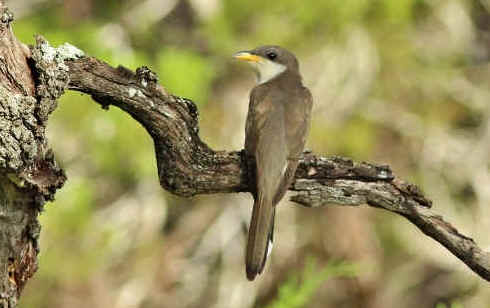
Yellow-billed Cuckoo
(photo by Rhett Poppe)
- Mangrove Cuckoo (ph) ______
Coccyzus minor
South of the US, the Mangrove Cuckoo has been seen during FONT
tours in the Cayman Islands, Costa Rica, Dominica, the Dominican
Republic, Jamaica, Mexico, Puerto Rico, Saint Lucia, Saint Vincent.
- Greater Roadrunner (*) (ph) ______
AZ:jan,jul,aug,sep
CA:sep TX:mar,apr,may
Geococcyx californianus
South of the US, the Greater Roadrunner has been seen
during FONT tours in Mexico.
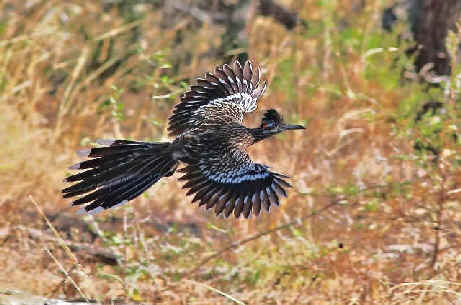
A Greater Roadrunner photographed in Texas
(photo by Rhett Poppe)
- Groove-billed Ani (*) (ph) ______
TX:may
Crotophaga suicirostris
South of the US, the Groove-billed Ani has been seen
during FONT tours in Belize, Costa Rica, Ecuador, Guatemala, Honduras, Mexico,
Panama, Venezuela.
- Smooth-billed Ani (ph) ______
Crotophaga ani
South of the US, the Smooth-billed Ani has been seen during FONT
tours in Argentina, Bolivia, Brazil, the Cayman Islands, Costa Rica, Dominica, the Dominican
Republic, Ecuador, Jamaica, Mexico (Cozumel Island & the Yucatan),
Panama, Paraguay, Puerto Rico, Saint Lucia, Saint Vincent, Venezuela.
- Common Cuckoo (*) ______ (r/US)
AK:jun (PI)
Cuculus canorus
A widespread Old World species, migratory. In Alaska, it is a rare
spring and summer visitor to the western & central Aleutian Islands, and
to the Pribilof Islands. There is also a late-June record in Anchorage,
Alaska.
In eastern North America, there is a record of one, as a vagrant, on the
offshore island of Martha's Vineyard, Massachusetts.
As the Common Cuckoo and the following species, the Oriental
Cuckoo, can be so similar when seen and not heard, some birds over the
years in Alaska could have been either.
Outside North America, the Common Cuckoo has been seen during FONT
tours in Bulgaria, Hungary, Japan (including Hegura Island), Poland,
Romania, Slovakia, Spain.
- Oriental Cuckoo ______ (r/US)
Cuculus optatus (formerly C. saturatus)
An east Asian species, migratory. It has occurred as a rarity in Alaska
from the late spring through the fall in the western Aleutian islands, the
Pribilof Islands, and on St. Lawrence Island. It has also occurred (once) in
mainland Alaska.
Outside North America, the Oriental Cuckoo has been seen during FONT
tours in Japan, including Hegura Island.
To
Top of Page



 The
Birds
of
The
Birds
of 












































